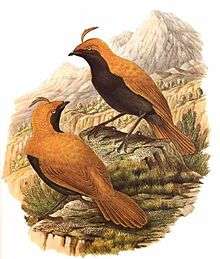Satinbird
| Satinbirds | |
|---|---|
 | |
| Cnemophilus macgregorii | |
| Scientific classification | |
| Kingdom: | Animalia |
| Phylum: | Chordata |
| Class: | Aves |
| Order: | Passeriformes |
| Suborder: | Passeri |
| Family: | Cnemophilidae |
| Genera | |
The satinbirds or cnemophilines, are a family, Cnemophilidae of passerine birds which consists of three species found in the mountain forests of New Guinea. They were originally thought to be part of the birds-of-paradise family Paradisaeidae until genetic research suggested that the birds are not closely related to birds-of-paradise at all and are perhaps closer to berry peckers and longbills (Melanocharitidae). The current evidence suggests that their closest relatives may be the cuckoo-shrikes (Campephagidae).[1]
Description
In each of the three species of satinbirds, the male is more brightly colored than the female, which is dull and inconspicuous. The male yellow-breasted satinbird has a yellow breast, black head and brown back. The male crested satinbird has a reddish to orange head, back and tail with a black throat and breast. The Loria's satinbird male is the least distinctive, being black. Satinbirds have weak, non-manipulative feet, wide gapes (at one time they were given the name "wide-gaped bird-of-paradise"), as well as an unossified nasal region. Their bodies are compact with rounded wings.[1]
Distribution and habitat
Loria's satinbird may have the broadest range in the central highlands, mostly from 2000–4000 m, but is inconspicuous except at fruiting trees. The crested satinbird inhabits high mountain forest and shrubbery. The yellow-breasted satinbird is the least known. Almost nothing is known of its biology, and it seems scarce and local within the patches of habitat along the central ranges east to the base of the Huon Peninsula.[1]
Behavior and ecology
All species of satinbirds build domed nests, unlike those of birds of paradise. The female lays a single egg and takes care of it without any assistance from the male. Satinbirds feed exclusively on fruit, even at a young age.
Species
- Genus Cnemophilus
- Loria's satinbird, Cnemophilus loriae
- Crested satinbird, Cnemophilus macgregorii
- Genus Loboparadisea
- Yellow-breasted satinbird, Loboparadisea sericea
References
- Cracraft, J. & Feinstein, J. (2000): What is not a bird of paradise? Molecular and morphological evidence places Macgregoria in the Meliphagidae and the Cnemophilinae near the base of the corvoid tree. Proc. R. Soc. B 267: 233–241.
- Burnie, David (2007): Bird: The Definitive Visual Guide: Page 371. Dorling Kindersley. ISBN 978-0-7566-3153-6